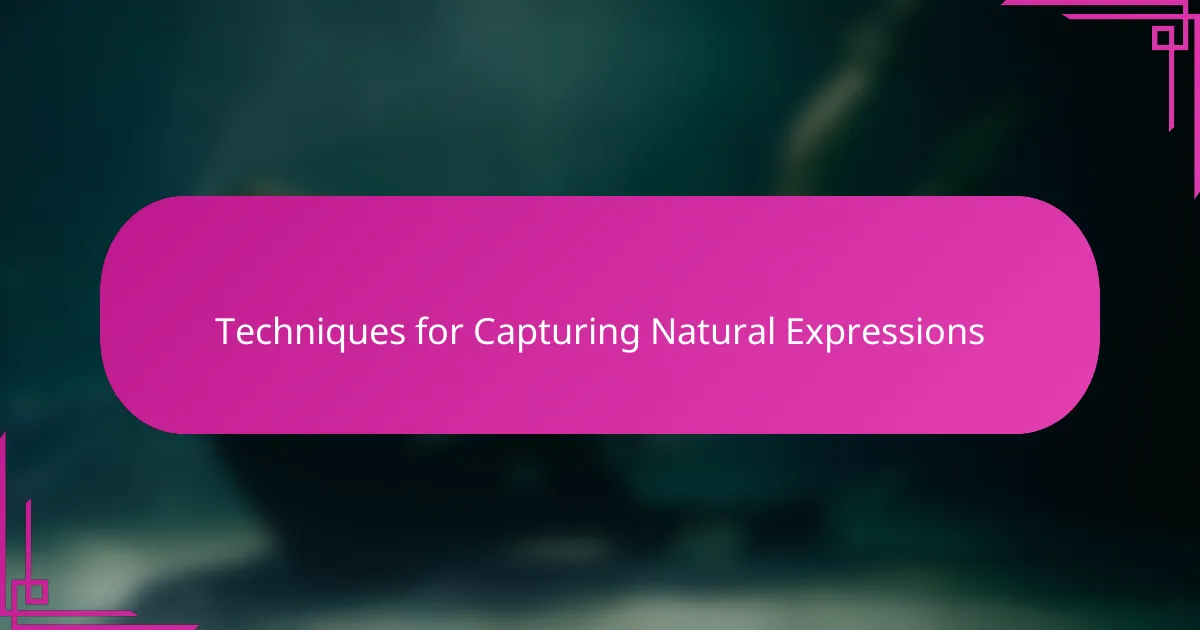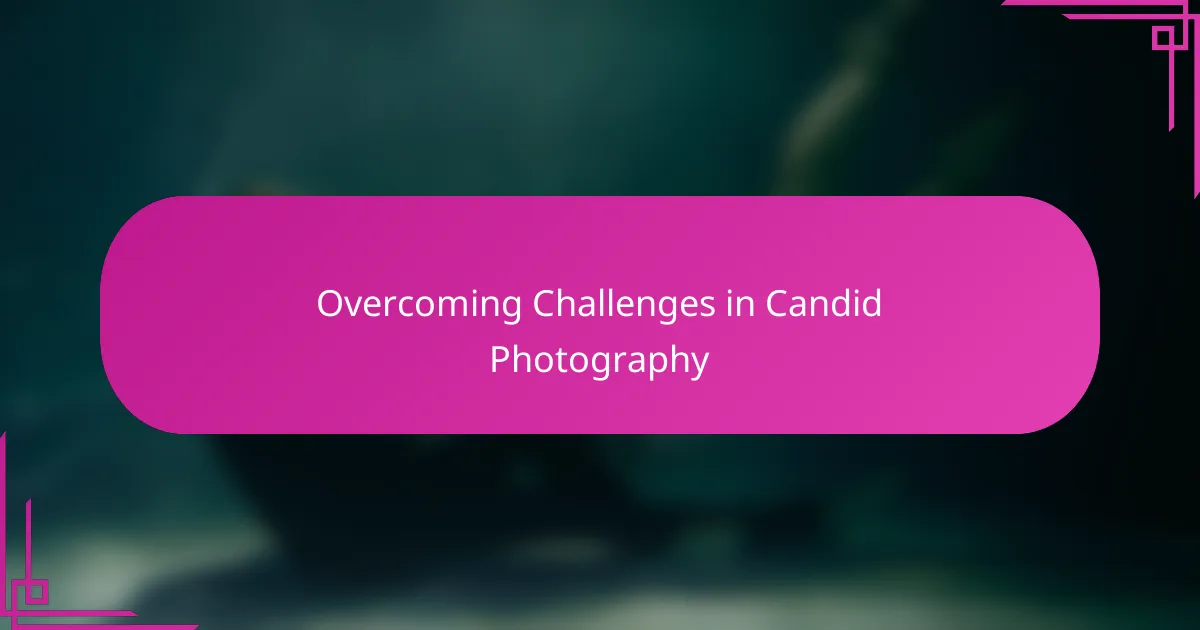Key takeaways
- Candid portraits capture authentic emotions and moments without posing, revealing deeper connections between the subject and the viewer.
- Essential equipment includes a lightweight camera and a fast prime lens, which allows for discreet shooting and a natural look.
- Manipulating lighting and camera settings, particularly during the golden hour, enhances the quality of candid shots.
- Patience, presence, and blending into the environment are key techniques for capturing genuine expressions without disturbing the moment.

Understanding Candid Portraits
Candid portraits, to me, are about capturing moments that feel truly alive—when the subject isn’t posing but simply being themselves. I remember once photographing a street musician; the raw emotion in his expression told a story no staged photo ever could. Isn’t it fascinating how these unguarded glimpses reveal so much more than a traditional portrait might?
What makes candid portraits unique is their spontaneity. They catch people off-guard, allowing authentic emotions and natural interactions to surface. I often find myself waiting patiently in the background, camera ready, anticipating that perfect unplanned moment. Have you ever noticed how these images invite you to connect with the subject on a much deeper level?
From my experience, understanding candid portraits means appreciating imperfection. Unlike posed shots, they embrace blur, awkward gestures, even unexpected distractions because these elements add life and truth. It asks us as photographers: can we let go of control and simply witness the human experience unfolding?

Essential Equipment for Candid Shots
When I think about essential equipment for candid shots, the camera itself is the heart of it all. For me, a lightweight mirrorless camera has been a game-changer—it’s discreet enough to avoid drawing attention but powerful enough to capture sharp, spontaneous moments. Have you ever tried holding up a bulky DSLR and noticed how it changes the vibe? That subtle difference in presence really affects the authenticity of your shots.
Another piece of gear I can’t live without is a fast prime lens, usually around 35mm or 50mm. These lenses let me work with natural light and produce beautiful background blur, which helps isolate the subject without the need for flash or interruptions. It’s almost like having a silent partner that helps you see the world through a more intimate frame. Do you find that a limited focal length actually pushes you to engage more with the subject and environment?
Lastly, don’t underestimate the value of extra batteries and memory cards. I’ve been in moments when the perfect candid smile appeared, only to realize my camera was dead or memory was full—nothing more frustrating. Being prepared means you won’t miss that fleeting blink of genuine emotion that you know will never come again. What’s your go-to strategy to stay ready for those unpredictable shots?

Techniques for Capturing Natural Expressions
One technique I swear by for capturing natural expressions is simply blending into the environment. When I manage to become almost invisible, people relax and forget the camera is there. I recall photographing at a friend’s casual backyard party—once I stopped announcing myself, the smiles and laughter became effortless and so much more genuine. Have you noticed how ease in presence can completely change the mood behind the lens?
Another approach I often use involves focusing less on the picture-perfect moment and more on interaction. Sometimes, I chat casually with my subjects or observe quietly from a distance, waiting for that authentic spark to surface. I’ve found these spontaneous exchanges not only build trust but also encourage those unguarded smiles and thoughtful glances that tell a real story.
Lastly, timing is everything. Instead of shooting a bunch of frames blindly, I train myself to anticipate the emotional peaks—those brief instances when someone’s face lights up or softens unexpectedly. It took practice, but now I recognize subtle cues: a quick glance, a shift in posture, a fleeting laugh. Do you ever catch yourself holding your breath and clicking at just the right moment? Those are the shots that feel like little windows into someone’s soul.

Ideal Settings and Lighting Tips
Lighting has always been my secret weapon for candid portraits. I prefer shooting in natural light whenever possible, especially during the golden hour—the hour just after sunrise or before sunset—because the soft, warm tones add an organic glow that feels genuine. Have you ever noticed how harsh midday sun can make people squint or create unflattering shadows? That’s why I avoid it when I can, opting instead for shaded areas or diffused light to keep expressions relaxed and natural.
When it comes to camera settings, I often rely on a wide aperture, like f/1.8 or f/2.8, to create that beautiful background blur that helps the subject pop without distractions. Using a higher ISO can be a lifesaver indoors or in low light—you just have to accept a bit of grain as the price for preserving the moment. I remember one evening shoot in a dim café where cranking my ISO allowed me to capture genuine smiles without a flash disrupting the vibe—that balance between technical adjustment and emotional integrity is what makes candid photography so rewarding.
Shutter speed is another crucial factor I pay close attention to. I prefer a faster shutter speed, around 1/250 or higher, to freeze fleeting expressions before they vanish. Yet, sometimes I deliberately slow it down to introduce a slight motion blur, which can add a sense of movement and spontaneity. Do you ever experiment with these subtle settings to see how they change the storytelling of your images? Playing with light and exposure settings isn’t just technical—it’s a creative dialogue between you and the moment unfolding.

Overcoming Challenges in Candid Photography
One of the biggest hurdles I face in candid photography is the delicate balance between being present and invisible. It’s tricky—you want to capture moments without disturbing them, but it’s hard to blend into the background when you’re holding a camera. I remember once at a crowded market, I had to slow my breathing and soften my movements just to avoid pulling attention away from a lively family scene. Have you tried just becoming part of the atmosphere instead of an outsider?
Another challenge is dealing with unpredictable lighting and fast-moving subjects. I’ve missed more than one shot because the light shifted or someone moved too quickly. Over time, I learned to anticipate movement and adjust my settings on the fly—sometimes sacrificing perfect sharpness for genuine emotion. Isn’t it funny how those imperfect snaps often tell the best stories?
Lastly, managing the nerves—both mine and the subject’s—can be tough. When people sense a camera pointed at them, they can freeze or put on a facade. I’ve found that a simple smile or a small comment is enough to break the ice and ease tension, making it easier to capture authentic expressions. What little gestures have helped you build trust and capture honesty through the lens?

My Personal Approach to Candid Portraits
For me, the heart of candid portraits lies in patience and presence. I don’t rush; instead, I let moments unfold naturally, trusting that genuine emotion will reveal itself when the subject feels least observed. Have you ever noticed how the best candid shots often come from simply waiting and watching quietly without interference?
I also rely heavily on intuition and spontaneity. Sometimes, I don’t even raise the camera until I sense the right energy in the air—a fleeting smile, a shared glance, or a subtle gesture that tells a story. In those seconds, it feels like I’m capturing a secret everyone else might miss, making the portrait deeply personal and true.
Lastly, I strive to maintain a connection without intrusion. I’ve learned to move softly, keep my expressions neutral, and avoid abrupt actions that might break the moment’s authenticity. Isn’t it amazing how just a calm presence can encourage people to forget the lens altogether and be themselves?

Tips for Improving Your Candid Shots
One tip I always come back to is to stay patient and observant. It’s tempting to shoot constantly, but sometimes the magic happens in those quiet pauses when you’re simply watching. I recall waiting by a café window for nearly twenty minutes, just soaking in the scene until a passerby’s genuine laughter caught my eye—those moments are worth every second of waiting, don’t you think?
Another thing I’ve learned is to trust your instincts and keep your camera settings ready to react quickly. There was this one time during a family gathering when a spontaneous hug happened so fast I almost missed it. Luckily, my shutter speed was set high, and I caught that fleeting embrace perfectly. Have you ever felt your heart race just before snapping that one perfect candid shot?
Finally, blending into the environment cannot be overstated. When people forget you’re there, their guard drops, and authenticity shines through. On a recent outdoor shoot, I deliberately wore neutral colors and moved slowly, and it amazed me how the subjects relaxed entirely. Have you noticed how this approach changes not just the photos, but the entire experience?